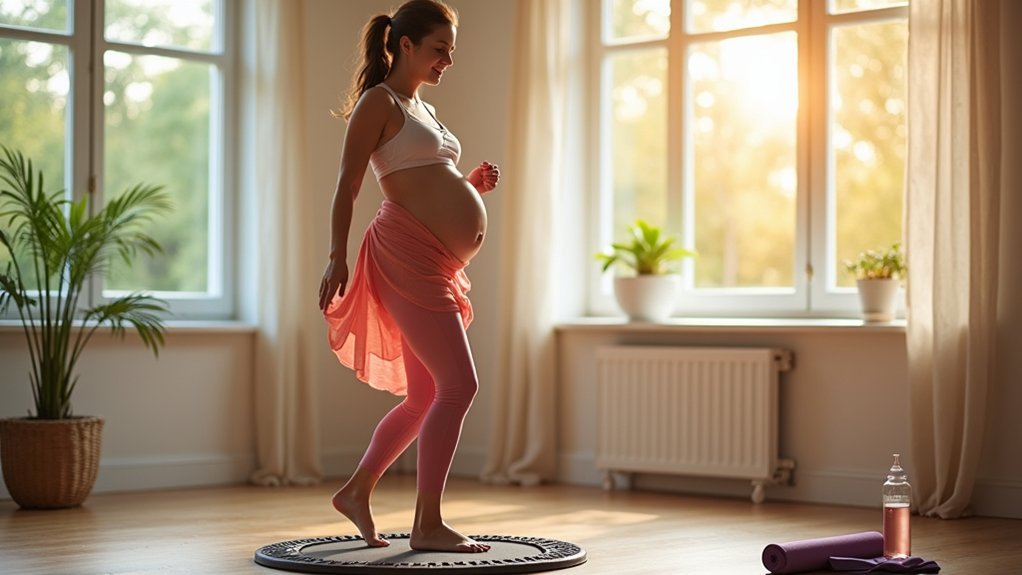During pregnancy, swap high-impact rebounding for safer alternatives that protect your changing body. Try stationary cycling, swimming, prenatal yoga, or gentle bouncing on an exercise ball instead of mini trampolines. These options reduce the 2-6 G-forces that could strain your pelvic floor and abdomen. Partner-assisted movements and proper breathwork techniques enhance safety and effectiveness. As your pregnancy progresses, adjust your routine with trimester-specific modifications that support both you and your baby’s health.
Why Rebounding Needs Modification During Pregnancy

Although rebounding offers an enjoyable, low-impact workout for many fitness enthusiasts, it requires significant modifications during pregnancy to guarantee safety for both mother and baby.
When you jump on a rebounder, your body experiences 2-6 G-forces that impact your abdomen and pelvic floor—areas already vulnerable during pregnancy.
Your body’s pregnancy hormones cause pelvic floor tissue laxity, making you more susceptible to strain or injury during high-impact movements.
Additionally, your growing belly shifts your center of gravity, compromising balance and increasing fall risks both on and off the rebounder.
Without definitive studies on how rebounding-generated G-forces affect fetal health, it’s best to adopt gentler alternatives like “health bouncing” where your feet maintain contact with the mat, especially when using stabilizing handles for support. Pregnant women should consider that repetitive high impact rebounding may further increase their already elevated risk of developing pelvic floor issues during and after pregnancy.
Low-Impact Mini Trampoline Alternatives for Each Trimester
While mini trampolines aren’t safe during pregnancy, you’ll find excellent low-impact alternatives for each trimester.
In your first trimester, focus on walking, swimming, stationary cycling, and prenatal yoga to maintain fitness without risking falls. Aim for at least 150 minutes weekly of these moderate intensity exercises to support your changing body.
As your pregnancy advances into the second and third trimesters, you’ll need to modify further with options like prenatal barre, water aerobics, and specially designed low-impact HIIT routines that accommodate your changing body.
First Trimester Techniques
Since mini trampolines pose balance and fall risks during pregnancy, your first trimester workouts should focus on safer alternatives that maintain cardiovascular benefits without the impact.
Incorporate stationary cycling on flat terrain and brisk walking at a conversational pace for 30 minutes to elevate your heart rate safely. Replace bouncing movements with water-based cardio that provides natural resistance. Always remember to consult your doctor before starting any prenatal exercise program, as recommended by certified trainers.
For strength and stability training, try:
- Reverse lunges paired with bicep curls for full-body engagement
- Bird dog exercises to enhance core stability without abdominal pressure
- Modified side planks with bent knees to strengthen your lateral core
- Bodyweight squats with a widened stance to accommodate your changing center
- Resistance band work for gentle leg and arm strengthening
Advanced Trimester Adjustments
As your pregnancy progresses beyond the first trimester, you’ll need to adapt your workout routine to accommodate your changing body and guarantee both safety and effectiveness. The mini trampoline that once energized your cardio sessions should now be replaced with gentler alternatives. Consulting healthcare providers regularly is essential when modifying your exercise regimen throughout pregnancy.
| Trimester | Safe Alternatives | Benefits | Modifications |
|---|---|---|---|
| Second | Swimming, walking | Joint protection, cardiovascular support | Use chair support for balance |
| Second | Prenatal yoga, stationary cycling | Flexibility, controlled cardio | Focus on breath work |
| Third | Pelvic floor exercises, modified planks | Labor preparation, core stability | Elevate hands on bench/wall |
| Third | Resistance band work, seated movements | Muscle maintenance, reduced strain | More frequent rest breaks |
Remember to engage your core and pelvic floor during all exercises, and always maintain the “talk test” level of exertion to ascertain you’re working at a safe intensity.
Bouncy Core Work: Protecting Your Pelvic Floor

When considering prenatal core workouts, it’s essential to protect your pelvic floor while still maintaining strength and stability. Instead of high-impact bouncing, use a pregnancy ball for gentle yet effective core engagement. The ball offers versatile support while minimizing strain on your pelvic muscles. Proper breathing and movement techniques are more important than specific exercises when working your core during pregnancy.
- Try gentle rocking movements on the ball to simulate bouncy motions without the impact.
- Combine Kegel exercises with ball sitting to strengthen your pelvic floor.
- Practice pelvic tilts while seated to engage your transverse abdominis.
- Use the wall for supported ball squats to maintain stability.
- Incorporate diaphragmatic breathing during all exercises to enhance core-pelvic connection.
Remember that these movements prepare your body for labor while preventing complications like diastasis recti and incontinence.
Always get medical clearance before starting any prenatal exercise routine.
Stabilizing Exercises for Safer Rebounding Sessions
Rebounding exercises during pregnancy require proper stabilization techniques to guarantee safety for both mother and baby. Start with pelvic brace activations by gently contracting your abdominal and pelvic floor muscles before any movement on the rebounder.
Replace high-impact movements with modified alternatives—swap jumping jacks for squat side steps and high knee runs for controlled marches.
Bird dog exercises performed in tabletop position strengthen your core while maintaining proper spinal alignment.
Focus on building lower body strength through modified squats and lunges to enhance stability during rebounding.
Side-lying leg lifts and glute bridges specifically target hip stabilizers essential for balanced landings.
When on the rebounder, move slowly with deliberate control, always maintaining neutral spine positioning to prevent coning and minimize stress on your changing body. The hormone relaxin softens ligaments during pregnancy, making controlled movements especially important for joint protection.
Monitoring Your Body’s Signals During Trampoline Workouts

Proper stabilization techniques form the foundation for safe rebounding, but learning to monitor your body’s signals takes your prenatal trampoline workouts to the next level of safety.
As pregnancy alters your cardiovascular system and balance, traditional heart rate monitoring becomes less reliable—rely instead on how you feel.
- Use the talk test—if you can’t hold a conversation while bouncing, you’re working too hard
- Aim for a 13-14 rating on the Borg scale (moderate to somewhat hard exertion)
- Stop immediately if you experience dizziness, unusual shortness of breath, or pelvic pain
- Watch for changes in fetal movement or uterine contractions as signals to stop
- Adjust your workout intensity as pregnancy progresses—reduce bounce height and duration in later trimesters
Remember to pay attention to warning signs and discontinue exercise if you experience vaginal bleeding, regular painful contractions, or calf pain/swelling which could indicate potential complications.
Partner-Assisted Rebounding Modifications for Safety
Partner support during prenatal rebounding workouts provides essential stability as your center of gravity shifts throughout pregnancy.
You’ll find that having a partner assist with modified techniques like health bouncing and controlled movements greatly reduces your risk of falls while still maintaining exercise benefits.
Your partner can help monitor your form, provide gentle support at your hips or torso, and assist with changes between movements to keep your workouts both safe and effective. This approach to prenatal workouts recognizes that pregnancy requires continuous assessment of symptoms while still allowing you to develop strength and balance in a modified way.
Partner Support Benefits
While steering through the challenges of prenatal fitness, having a supportive partner by your side can transform your exercise experience from simply manageable to truly beneficial.
Partners who stay physically active themselves are more likely to motivate you through demonstration rather than just words, creating an atmosphere of mutual accountability. A partner who understands the psychological effects of pregnancy can provide tailored emotional support during your exercise journey.
- Your active partner provides essential stability during modified rebounding exercises, reducing fall risks.
- Shared prenatal workouts release oxytocin, strengthening your emotional bond while reducing anxiety.
- Partners who attend classes with you learn proper techniques to assist with balance and posture alignment.
- Their practical household support frees your time and energy for consistent exercise routines.
- Exercise together creates informed advocates who understand your physical limitations and can help communicate them during prenatal appointments.
Modified Rebounding Techniques
Safety takes center stage when adapting rebounding exercises during pregnancy. With your partner’s assistance, you’ll create a secure environment for gentle bouncing workouts.
Keep one foot on the mat during movements to reduce pelvic floor strain. Try seated rebounding or low-impact marching as alternatives to jumping. Your partner can provide handheld stability during single-leg exercises and monitor your changes between positions.
Replace full jumps with small, rhythmic pulses while maintaining proper alignment. Your partner should verify mat tension before each session and confirm you’re wearing non-slip footwear. They’ll also remind you to exhale during exertion to minimize intra-abdominal pressure. This helps prevent pelvic floor problems that can result from higher-impact rebounding activities.
Limit sessions to 5-10 minutes with 20-second active intervals followed by 40-second rest periods. Always avoid hip twisting movements and plyometrics entirely.
Transitioning From High-Impact to Gentle Bounce Techniques
As pregnancy progresses, your body requires gentler forms of exercise that accommodate your changing physique.
Exercise balls offer the perfect solution for shifting from high-impact movements to safer bounce techniques that still provide effective workouts.
Embrace the gentle bounce of exercise balls—your pregnancy-friendly pathway to effective, low-impact fitness.
- Replace jumping jacks with gentle bouncing on a stability ball to help position your baby ideally.
- Swap running for hip circles that promote mobility while easing sciatic pain.
- Trade traditional core work for ball rollouts that engage your core while maintaining proper alignment.
- Substitute high-impact cardio with supportive squats using a wall or ball.
- Integrate deep breathing with all movements to relax your pelvic floor.
Gentle bouncing on an exercise ball can be particularly beneficial as it may assist with cervix dilation while simultaneously providing a soothing motion for your baby.
Always get medical clearance before starting any prenatal exercise routine, and listen to your body—stop immediately if you experience discomfort or pain.
Breathwork Practices to Pair With Modified Rebounding
Integrating mindful breathing techniques with your modified rebounding routine can transform a simple prenatal workout into a holistic experience that benefits both you and your baby. By combining gentle bouncing with intentional breath patterns, you’ll reduce stress, increase oxygen flow, and prepare your body for labor. These breathing exercises can significantly enhance maternal physical health while supporting fetal development through proper oxygenation.
| Technique | Benefits | When to Use |
|---|---|---|
| Diaphragmatic | Engages core, supports pelvic floor | During gentle bounces |
| 4-7-8 Breathing | Induces relaxation, regulates exertion | When feeling anxious |
| Box Breathing | Maintains steady rhythm | During interval training |
| Ujjayi Breath | Enhances cardiorespiratory balance | For sustained bouncing |
Remember to avoid breath holds exceeding 7 seconds and stop immediately if you experience dizziness. Focus on lengthening exhalations to activate your vagus nerve, which can help manage pregnancy nausea while exercising.
Post-Pregnancy Return to Full Rebounding: A Timeline
Returning to a rebounding routine after childbirth requires patience and attentiveness to your body’s healing process. The journey back to full-intensity rebounding should follow your body’s gradual healing timeline, not arbitrary deadlines.
- Weeks 1-6: Focus on rest, pelvic floor exercises, and gentle walking; rebounding is contraindicated during this initial recovery phase.
- Weeks 6-12: Begin modified, low-impact movements only after medical clearance; address any diastasis recti or pelvic floor weakness first. Most new parents feel mostly recovered by this time, though individual healing rates vary significantly.
- 3-6 Months: Gradually introduce low-height bounces if core strength has improved and no complications exist.
- 6-12 Months: Progressively increase intensity as musculoskeletal recovery advances.
- 12+ Months: Full return to high-intensity rebounding when pelvic floor function normalizes and you experience no pain or leaking.
Frequently Asked Questions
Can Rebounding Help With Pregnancy-Related Water Retention?
Yes, rebounding can help with your pregnancy-related water retention. It stimulates lymphatic circulation, enhances fluid movement through g-force effects, and activates muscle contractions that reduce stagnation. Always consult your doctor before starting.
How Do Mini Trampoline Workouts Affect Balance During Pregnancy?
Mini trampoline workouts improve your balance during pregnancy by strengthening core and leg muscles, enhancing spatial awareness, and activating stabilization muscles. You’ll develop better dynamic balance, helping you adapt to your changing center of gravity.
Are Seated Bouncing Exercises on Exercise Balls Safe Alternatives?
Yes, you’re safe using birthing balls (not regular gym balls) for seated bouncing during pregnancy. They’re designed for pregnancy weight, improve posture, engage core muscles, and may help position your baby effectively for labor.
Can Rebounding Cause Premature Labor in High-Risk Pregnancies?
Yes, rebounding could potentially trigger premature labor in high-risk pregnancies. The repetitive impact and vertical forces might stress your cervix or stimulate contractions, especially if you have conditions like cervical insufficiency or prior preterm birth.
Should Heart Rate Limits Differ When Using Mini Trampolines?
While heart rate limits don’t specifically differ for mini trampolines during pregnancy, you should focus on perceived exertion rather than strict numbers. Stay within moderate intensity and listen to your body’s signals when rebounding.
In Summary
You’ve got plenty of safe options to stay active without traditional rebounding during pregnancy. Listen to your body, modify movements as needed, and remember that gentle bouncing with proper support can still provide benefits. Once your baby arrives and your doctor clears you, you’ll gradually return to your regular rebounding routine. Until then, enjoy these pregnancy-friendly alternatives that keep you moving safely.





Leave a Reply